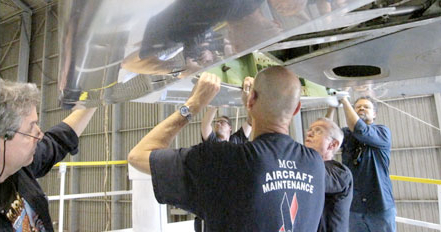 Sitting in an airplane, taxiing from gate to runway, the last thing you want to think about is the safety and oversight of the repair work performed on your aircraft. And you wouldn’t have to if the thousands of mechanics and inspectors who work to keep our passenger aircraft flying safely had their way.
Sitting in an airplane, taxiing from gate to runway, the last thing you want to think about is the safety and oversight of the repair work performed on your aircraft. And you wouldn’t have to if the thousands of mechanics and inspectors who work to keep our passenger aircraft flying safely had their way.
Represented by our member unions, the Transport Workers Union, the International Association of Machinists and the Professional Aviation Safety Specialists (inspectors), these dedicated professionals have been advocating with us for years for better safety and security regulations of aircraft repair work that is contracted out.
Now a new report is calling attention, once again, to shortcomings in our government’s system for overseeing the repair and maintenance of U.S. aircraft. It declares: the Federal Aviation Administration “does not have an effective oversight process for foreign and domestic repair stations.”
Here’s a bit of background:
The Reagan Administration weakened rules more than 20 years ago opening the floodgates to outsourcing with little or no safety oversight. Today, hundreds of FAA-certified facilities dot the globe thanks to explosive growth in outsourcing. Aircraft repair work is now done at 4,800 repair stations from Brazil, China and Peru to Georgia and California.
As we noted last November, “…of the 71 percent of heavy maintenance that is now farmed out by U.S. airlines, 27 percent of that work goes overseas where regulations often fail to live up to the standards imposed in America.” In 1996, U.S. carriers spent $1.5 billion on contract maintenance – that figure almost tripled to $4.2 billion in 2011. By 2021, experts predict $76 billion will be going to contract repair stations located both in this country and around the world.
That places a crucial burden on the FAA to make sure enough well-trained professionals are using a rational, consistent system to repair, maintain and inspect aircraft at outsourced facilities. But the DOT IG’s report confirmed what we have known for a long time — the FAA has not provided its inspection workforce with the tools or training it needs to do an effective job.
And when oversight is lax, problems at the stations can occur. Of the 27 repair stations examined by the IG, 21 did not maintain accurate training records, 13 had weaknesses in their tool and equipment programs and 10 had deficiencies in their maintenance processes.
This is also why we have advocated aggressively for reforms that reflect today’s airline industry and have called out airlines such as JetBlue that rely heavily on foreign repair stations that, as this IG report points out, often fail to meet U.S. safety standards.
We owe the flying public a better way to oversee our aircraft repair system. We need regulations that reflect the epidemic levels of outsourcing that define today’s airline industry.